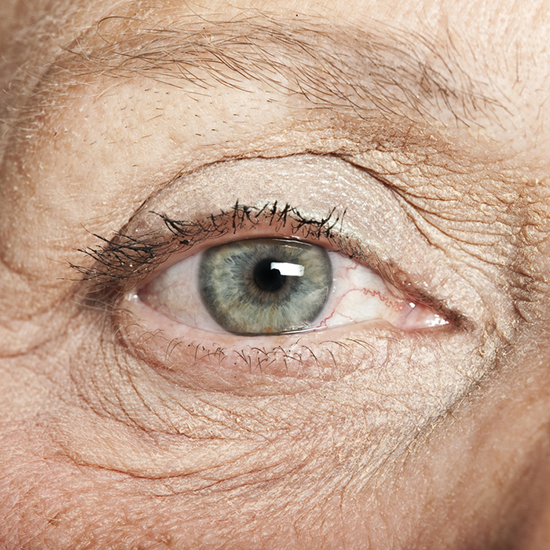Do Your Eyes Show Your Age? A Conversation With Dr. Rondi Walker

![]()

What most bothers FOFs about their eyes?
Patients start having concerns about their eyes when others tell them they look tired. Or when they look in the mirror and they think they look sad, tired or older than they feel. Heavy-looking upper eyelids usually bother them most. Women also will tell me they’re having trouble putting on makeup. Their mascara winds up on their upper eyelids, instead of on their lashes.
Does the extra skin on the upper eyelids make them look heavy?
It could be excess skin, fat or muscle in the upper eyelid. Or it could be browtosis, when the position of the brow has changed. You can’t assume the problem is simply with the excess skin, when it’s really the brow that needs to be elevated and only a minimal amount of skin should be removed.
Where should our brows be located?
Ideally, the brow sits at the level of the frontal bone, right on the brow ridge. If you take your fingers and palpate along the lower portion of the frontal bone, right above your eye socket, you’ll feel your frontal ridge. That’s where the eyebrow should sit.
What causes browtosis?
Brows begin to sit lower as our collagen and tissue thin out and gravity and laxity set in. It can be likened to what happens to other parts of our body. Some women also have a genetic propensity for browtosis. If their parents had it, they likely will have it, too.
The skin falling from the brow therefore crowds the upper eyelid, which causes a heavy appearance. Often, all we have to do is lift the upper brow, especially for a woman in her 30s or 40s. By 50, however, many women also need to address the excess eyelid skin. It is important to determine if browtosis is present and treat that as well.
Which is more prevalent in FOFs: Excess upper eyelid skin or browtosis?
At least 40 percent of women over 50 have browtosis, some developing it when they’re younger. Whether you age more in your upper or lower face depends on a few factors, including genetics and your face shape. Narrow jaws, short necks, and thin skin are worse for aging. The best attributes for aging are heavy, fatty faces, square jaw lines, prominent cheek bones, wide set eyes, thick lips, dark and oily skin.
What do you do with excess fat in the eyelids?
Years ago, surgeons took out all the fat in the upper and lower eyelids, removed muscle and created a hollow, deer-in-the-headlights look, which used to be considered a classic look. Over the course of the last 30 years, we realized people didn’t look good with that hollowness and we started to preserve the fat, or removed very little.
Sometimes, we reposition the fat in the upper eyelid fold to make the upper eyelid fold full. Fat in the face and around the eye, positioned correctly, is a sign of youth. I rarely remove fat from lower eyelids unless a patient has very large bags (these are called malar bags and sit right over the cheekbone).
Can you insert fat into the eye area?
If someone is very hollow, we can inject fat into her brow roll, the temples, or the tear trough (the area between the nose and the bony rim of the lower portion of the eyelid socket). Additional fat in the lower eyelid structure provides support, smoothens out the area and gives eyes a more youthful appearance.
We lose soft tissue and fullness in the area as we age; the fat starts to migrate away and we see a little trough, or hollowness, that creates a shadow that makes us look tired and older. In younger patients, we can fill in the trough and cover the dark shadow with filler, such as Restylane. Or we can use a patient’s own body fat.
Skin is always darker under the eyelids than the skin on the rest of the face, so we naturally have a slight shadow under the eye—it is just more prominent in some individuals than others.
Are eyes usually done along with a facelift?
I rarely do a facelift without doing the eyes at the same time. Eyes alone are usually done on younger patients who don’t need facelifts.
If a FOF had her eyes done alone, would that be a mistake?
No, it wouldn’t be a mistake if that’s someone’s preference, but we wouldn’t want to overdo it by giving a patient very youthful eyes without telling her that the rest of her face might look a little more aged.
Sometimes, patients just want their upper eyelids treated, preferring to leave the lower eyelids alone. It wakes them up, and they look more youthful. They’re perfectly happy with that. If what the patient wants is within reason, I do it. She understands I could do more to make her look better, but she doesn’t want more involved, as well as costly, surgery.
Often, women have their eyelid surgery done first and come back for the facelift, but most surgeons offer packages, which makes it more economical to do both procedures at the same time.
Which goes first, the eyes or the face?
It depends on the patient. Some patients come in with perfect eyes. They have big, gorgeous eyes and they don’t have much skin excess or big fat pads. Others have heavy jowls and excessive laxity—they need facelifts! It depends on several factors, such as the quality of the skin, how the brow sits, and genetics. It’s a very individual thing.
Are there any 70-year-old women who don’t need work?
Women with thicker and darker skin, including Mediterranean and women of color, often age without a wrinkle, especially if they’ve maintained their weight.
Does fat cause puffiness under the eyes?
Yes, it’s usually fat. The orbital septum becomes weaker, our muscle becomes more lax and stretched, and the collagen thins, becoming more disorganized. Our tissues can’t hold the fat back as well as we did when we were younger and so the fat protrudes more.
I will remove a little bit of skin from the lower lids and try not to disrupt the muscle. I tend to re-suspend the muscle in older patients, using a procedure called the Orbicularis Hitch. I hitch the muscle and tighten it to the lateral rim of the orbit to create a nice smooth line underneath the eye.
What’s the best way to get rid of fine lines and wrinkles around the eyes?
I do CO2 laser resurfacing around the lower eyelid to get rid of very fine lines and wrinkles that are caused by smiling, laughing and movement of the muscles over time. Skin becomes fine, thin and crepe-like as we age. The laser creates a superficial and controlled burn or damage that disrupts or destroys old collagen, which in turn lays down new collagen as it heals. The new skin is smoother, tighter and thicker.
Botox injections also stop the movement of the muscles that cause these fine lines and wrinkles, but the movement returns when the Botox wears out.
What are your fees for eye surgery?
They range from $3,000 to $7,500 for both eyes, depending on what you have done. Upper eyelids alone would be at the lower range; upper and lower eyelid surgery, combined with the CO2 laser and Botox would be at the upper range.
What are the dangers of eyelid surgery?
Dry eyes, ectropion (pulled down lower lid), inability to close the eyes, and in rare cases, blindness. In those cases where blindness has been reported, it is associated with extreme pain and bleeding after surgery. A blepharoplasty is not a painful operation. If the patient is experience extreme pain, it is indicative of pressure build up within the orbit. This pressure compresses the optic nerve and can lead to blindness if the pressure is not relieved. It is easily treated by releasing all the sutures and placing the patient on medication. There have only been a few reported cases of true blindness secondary to blepharoplasty. These complications are extremely rare. In general, this is a very safe procedure, and the operation most commonly performed by all plastic surgeons nationwide.
![]()
.

Dr. Rondi K. Walker
Walker Plastic Surgery
3301 New Mexico Avenue Northwest
Washington, D.C. 20016
Tel: (202) 364-6673
Fax: (202) 686-0257
www.walkerplasticsurgery.com/
![]()

